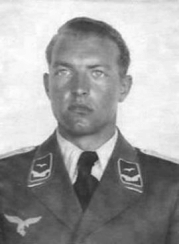Helmut Woltersdorf was a German Luftwaffe flying ace and night fighter ace of the World War II. Woltersdorf is credited with 24 victories, including 20 Royal Air Force (RAF) bomber aircraft. Woltersdorf flew the Messerschmitt Bf 110 and Dornier Do 215 night-fighter.
Woltersdorf initially joined II. Gruppe Zerstörergeschwader 141, based at Padubitz until May 1939, when it was renamed I./ZG 76. Woltersdorfs first kill came on 2 September 1939 over Poland. While escorting Dornier Do 17s he shot down a PZL P.11 fighter. He was to score his second kill against this type on 9 September.
During the Norwegian Campaign Helmut scored four kills against RAF Vickers Wellington bombers, two on the 12 April and two victories on 30 April.
During the Battle of Britain Woltersdorf claimed two Spitfires on 15 August, his only kills of the battle. I./ZG 76 had been withdrawn from the front-line in September 1940 to re-train in the night-fighter role.
Defending Belgian and Dutch air space, Woltserdorf destroyed nine Wellington, three Handley Page, two Avro Manchester, one Lockheed Ventura and a single Handley Page Halifax between 12 May 1941 and 2 June 1942.
On the night of 6/7 July 1941 Woltersdorf, now flying a Dornier Do 215B-5 night fighter equipped with the Infra-Red “Spanner-Anlage” detection apparatus, assigned to NJG I, was forced to crash land just off the Dutch coast, after his aircraft was damaged by a Vickers Wellington bomber he had shot down. Woltersdorf ditched his aircraft into the Waddenzee Sea.
In October 2007 the Dornier was discovered largely intact. It remains the only known Dornier in existence, and there is a good chance of it being recovered (see the Dornier Do 215 page for more details).
On 2 June 1942 Woltersdorf was shot down and killed by a Hawker Hurricane piloted by New Zealander Sergeant Peter Gawith of No. 3 Squadron RAF. The RAF unit had been conducting night sweeps over Europe since 11 December 1941 Gawith survived just two more months. On 28 July he was posted as missing in action over Noordwijk, Netherlands.
CLAIM 12 May 1941 Flying a Messerschmitt Bf 110, Handley Page Hampden Claimed over Enkhuizen at 02:57. Identified as Hampden AD900 (PL-?) attacking Bremen. Crashed at Hoogkarspel near Enkhuizen. Pilot Acting Squadron Leader Colin Guy Champion Rawlins (5 June 1919—23 October 2003) of No. 144 Squadron RAF was wounded and captured. Treated in the German naval hospital at Alkmaar.
Colin Guy Champion Rawlins
He joined the Oxford University Air Squadron and became an RAF reservist, before being called up in 1939. After advanced pilot training at Montrose and at Upper Heyford, he flew with 144 (Hampden) Squadron, of No 5 Group, Bomber Command, for a full tour of operations from August to December 1940. He was awarded his DFC in February 1941.
Having been rested, Rawlins pressed for a return to active operations and in May 1941 rejoined No 144 as a flight-commander. On only the second sortie of his next operational tour, he was shot down over Holland on the flight home from a raid on Bremen.
As a result of a broken ankle sustained in a low parachute jump, for three months he was laid up in a German naval hospital at Alkmaar, in Holland. He then spent the rest of the war in various German prisoner-of-war camps, including Stalag Luft III.
